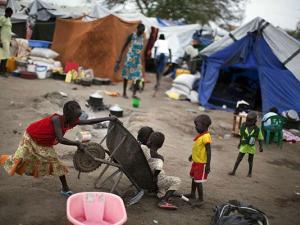
DR Congo and South Sudan lead in children killed in conflicts
War-ravaged South Sudan and violence-prone Democratic Republic of Congo account for the highest number of children killed in conflicts in Africa.
According to a new report, the two countries account for the biggest numbers of the nearly 1.2 million refugee population in Uganda.
Other countries listed by the report are Somalia, Central African Republic, Nigeria, Mali, Afghanistan, Yemen, Syria and Iraq.
The latest status report by UN agencies Unicef and United Nations High Commissioner for Refugees last month showed that children make up more than 60 per cent of the 794,000 South Sudanese and 312,000 Congolese refugees in Uganda.
A report by international charity Save the Children released on February 15 and titled Stop the War on Children, says five times more children than fighters are killed in conflicts across the world’s hotspots, including those in sub Saharan Africa that have exported the largest number of refugees between 2013 and 2017.
“This report shows the sheer horror and brutality that children who flee to Uganda are escaping,” said Brechtje van Lith, Save the Children’s country director for Uganda.
“Uganda has been a safe haven for refugee children for many years and it’s vitally important that this continues. Many of these children arrive scared and vulnerable, sick and malnourished, and emotionally scarred by the violence they have witnessed.
“We must do all we can to protect them from further harm and help rebuild their future,” Ms van Lith added.
Armed conflict
Worldwide, more children — almost one in five globally — are living in areas affected by armed conflict and war than at any time in more than 20 years.
The report estimates that at least 550,000 children are thought to have died as a result of armed conflict between 2013 and 2017 in the 10 worst-affected countries —translating into an average of over 100,000 every year.
The children succumbed to indirect effects of conflict and war such as hunger, damaged infrastructure and lack of access to healthcare and sanitation.
The children probably would not have died if they hadn’t been living in areas affected by conflict, Save the Children added.
In total, 870,000 children under five have died in conflict areas in the period under review — five times as many as the number of fighters killed.
The report shows that the number of grave violations against the rights of children — being killed or maimed, recruited by armed groups, abducted, falling victim to sexual violence, seeing their school attacked, or humanitarian aid denied — has almost tripled since 2010.
In many cases, children are specifically targeted with those in the DRC and South Sudan being particularly vulnerable.
Save the Children researchers interviewed numerous refugee children in Uganda, including six-year-old Akello (not her real name, in order to protect her identity), who was raped in eastern DRC when an armed group attacked her village.
She was separated from her parents and only just survived after two months in hospital, but her brother was killed in the attack.
Traumatised by these horrific scenes, Akello often wakes up screaming at night, and has stunted growth, and prefers to stay on her own away from other people, her mother revealed.
Thirteen-year-old Mangeni (not real name), told researchers that she was abducted from her village at the age of 11.
“One day people came and took my father away and tied him with ropes and took him to the forest and shot him dead. After the killing of my father they started beating and torturing me.
“They would step and kick on my ribs and stomach… They kept me for a long time with them in the bush and I used to cook and work for them. After cooking they would beat me up. I saw many bodies of people they had killed there.”
Education
The report recommends that it is important to urgently get refugee children back into education, to help them return to a sense of normalcy and have an opportunity for a better future.
Available data shows that 57 per cent of refugee children in Uganda are out of school, as well as 34 per cent of infants in the host communities.
Even for those who do attend school, classes are overcrowded and face a shortage of teachers and basic supplies.
To address these challenges, the UK charity wants the international community to fund Uganda’s recently launched Education Response Plan for refugees and host communities, which if funded would provide quality learning for more than 565,000 learners.
The report also recommends that governments and other influential organisations ensure children are protected during war and conflict, ranging from signing the Safe Schools Declaration to multi-year investment in humanitarian child protection, education and programmes to tackling sexual and gender-based violence.
But with an estimated five per cent of refugees arriving in Uganda alone and separated from their families, it is not unusual to find child-headed refugee families.
Source: www.theeastafrican.co.ke
